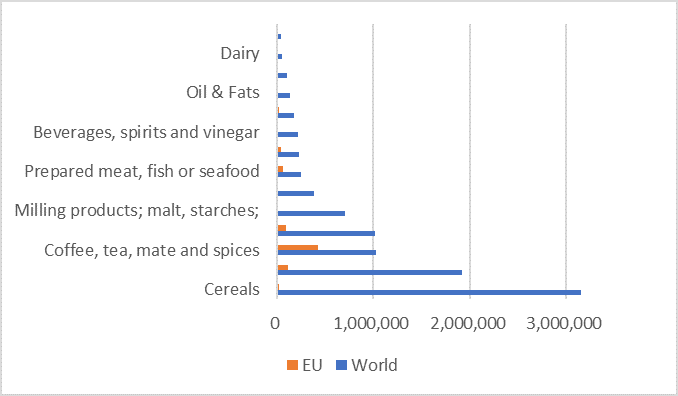EVFTA: An Overview of Food Products with Tariff Liberalization for EU Imports
Executive Summary
The EU-Vietnam FTA has taken effect as of August 2020. This is a comprehensive trade agreement that covers the elimination or deduction of import tariffs for most traded products and is expected to significantly improve Vietnam and the EU’s trade relations. This report covers products and potential trade opportunities for EU imports, focused on products with immediate import tariff elimination, for food and agricultural products such as rice, manioc starch, and sugar. This report also provides a list of food products that will benefit from immediate import tariff liberalization.
Market Overview
In 2018, Vietnam has exported 9.6 million metric tons (MT) of food and agricultural products globally, with 75% of Vietnam’s exports headed to Asia. China is Vietnam’s largest exporting partner, importing 3.3 Million MT from Vietnam (35% of Vietnam’s total exports). Although Vietnam mainly exports to Asia, the EU and the US are important trading partners as they rank second and fourth (9% and 8% respectively) of Vietnam’s export destinations.
Graph 1. Vietnam Global Food Exports to the World, 2018.

Out of EU’s global food import of 154 Million MT in 2018, 1.4 Million MT was imported from Vietnam, placing it in the 25th rank globally and fifth in Asia. The largest EU imports from Vietnam consists mainly of coffee, fruits, rice and fish, and seafood. Although Vietnam is already benefitting from EU’s Generalised Scheme of Preferences (GSP), the EVFTA is a far more comprehensive agreement and exports to the EU is expected to increase as most products will benefit from tax exemption/preferences (EU will liberalize 71% of their imports from Vietnam from day one and 99% will enter duty-free after seven years).
Vietnam's Exports to the EU
Vietnam’s top exports to the world include rice, fruits & nuts, coffee, fish & seafood, milling products, malt, and starches, with the largest being coffee. Vietnamese coffee accounts for 25% of EU’s total coffee imports of 3 Million MT, making it the second-largest and important trading partner (Vietnam sends almost half of their coffee exports to the EU). Despite Vietnam being one of the world’s largest producers of rice, export performance is substantially low compared to its competing countries, Myanmar, Pakistan, Thailand, India, and Cambodia.
Graph 2. Vietnam Exports to the EU vs. World (volume).

While Vietnam exported 25K MT of rice to the EU in 2018, competing countries have sent 1.5 million MT, accounting for 76% of the EU’s total imports. Vietnam is the second-largest exporter globally of manioc (cassava) starch (450,000MT) but falls back significantly behind Thailand, which exported 2.8 million MT globally in 2018. This is in line with EU imports, where out of the 146K MT, 26% of its manioc starch import was from Thailand and only 1.5K MT was from Vietnam.
Notable Opportunities for Vietnamese Products with Immediate Tariff Elimination
Rice
A total of 80K MT will be subject to duty-free tariff rate quotas for Vietnamese rice with base tariffs of 65~211 euros per 1,000 kg being eliminated. The average global export price of Vietnamese rice in 2019 was 433 USD/ton, only behind Myanmar’s 346 USD/ton. This tariff elimination will likely bring price competitiveness and reduce import hurdles from EU buyers, and more demand for Vietnamese rice is expected. In fact, the first batch of Vietnamese rice benefitting from EVFTA is scheduled to start sailing in early September 2020. The volume for the quota could potentially triple Vietnam’s current export volume, leading to a 2.4% increase in Vietnam’s market share for EU rice imports. For rice for sowing, the import tariff of 7.7% will be eliminated without quota, and broken rice will remove 50% of its 65 EUR/1,000kg import tariff at entry, and gradually remove the remaining 50% linearly after 5 years.

Manioc Starch
Despite being a major exporter of manioc starch, Vietnam has only exported 1.5K MT to the EU in 2018, while Thailand exported over 37K MT. The EVFTA allows the removal of import tariffs of 166 euros/1,000kg for 30K MT of manioc starch. The average global export price of Vietnamese and Thai manioc starch in 2019 was 417 USD/ton and 437 USD/ton, respectively, making Vietnamese manioc starch more expensive when the import tariff is included.
With the elimination of the import tariff and import quota volume, Vietnamese manioc starch will benefit from higher price competitiveness, and by exporting the entire quota volume, exports could potentially increase by 20 times compared to 2018, ranking the nation among the top four exporters to the EU.
Sugar and High-sugar Containing Products
20K MT of sugar and high-sugar containing products will be exempt from import tariffs. Although this represents only 1% of EU’s total imports, this will create opportunities for Vietnamese exporters as sugar exports to the EU have been almost non-existent in 2018 and 2019. Export products will likely be concentrated in cane sugar, as the EU is a major producer of beet sugar; Vietnam has produced more than 1.17 million tons of cane sugar in the 18-19 season, exporting around 73K MT globally.

Coffee
Vietnam is the second-largest exporter of coffee to the EU, with over 770K MT exported in 2018. It ranks first in price competitiveness among the top five exporting countries to the EU (Brazil, Honduras, Colombia, and Uganda) with an average EU import price of 1.93 USD/kg. Coffee products have already been benefitting from GSP preferential tariffs, but price competitiveness will improve with the EVFTA as the import tariffs will be eliminated, and products that are benefitting will be expanded to others such as decaffeinated coffee, coffee extracts, and coffee substitutes using coffee.

Crustaceans
Non-processed shrimps will be liberalized from import tariffs as the EVFTA comes into full force. Vietnam currently ranks fourth in EU’s imports of crustaceans globally, with a market share of 8%, and exports on average 22% of Vietnam’s total crustaceans to the EU. However, it will have to compete heavily with the other major exporters, Ecuador, Argentina, and India, which are playing in the market with higher price competitiveness.

Other Products with Import Tariffs Liberalized at EVFTA Day 1
Among the abovementioned products, the EU will liberalize 71% of their imports from Vietnam from day one, and 99% will enter duty-free after seven years through the EVFTA. The following table below shows a number of products with import tariffs being eliminated from day one.



Sources
- Tridge: https://www.tridge.com/
- UN Comtrade data: https://comtrade.un.org/data/
- ITC Trademap: https://www.trademap.org/
European Commission:
https://ec.europa.eu/info/food-farming-fisheries/plants-and-plant-products/plant-products/sugar_en
Guide to the EU-Vietnam Trade and Investment Agreements:
https://trade.ec.europa.eu/doclib/docs/2016/june/tradoc_154622.pdf
Tridge news: https://www.tridge.com/news/next-week-will-export-the-first-batch-of-rice-to-e




